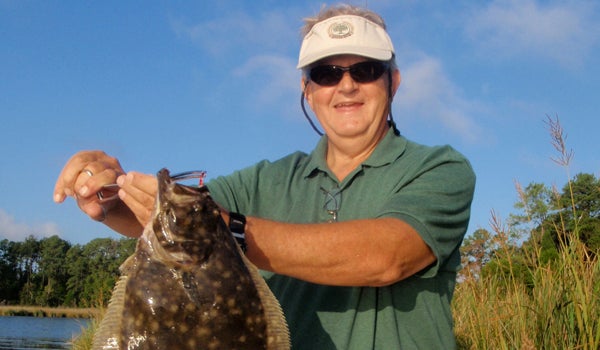Flounder fishing improving
Published 8:44 pm Thursday, July 9, 2015

FRED BONNER | CONTRIBUTED
CATCH OF THE DAY: Barry Taylor holds a nice flounder caught in very shallow water while using a spinner bait slow-rolled across the bottom.
Recreational gill-netters are reporting that they are catching good numbers of keeper-sized flounder when they reel in their each morning. That’s good, but when the sport fishermen, using standard spinning or casting gear, are reporting poor catches of flounder, something just “ain’t-right” here. Perhaps the sport anglers need to try some different methods of fishing for flounder.
Everyone knows that flounder are fish that lie along the bottom and, by using their very effective natural camouflage to hide and wait to ambush food, usually find plenty of minnows and shrimp to eat. The flounder tend to go where they food is found and this means that at night they find cover and food in shallow water. Flounder “giggers” have used the nighttime shallow water to their advantage for years to harvest some nice flounder.
At dawn when things lighten up in the shallows, the flounder usually retire to deeper water where they feel safer, but they’re still hungry. Since most sport fishermen prefer to practice their sport during daylight hours, they may find that their luck becomes better in the deeper water.
In most cases, the Pamlico Rover and its feeder streams have a distinct drop-off where the water depth gets deeper noticeably faster. If the area is lucky enough to have a good crop of aquatic vegetation, such as widgeon grass, the grass usually disappears as the water depth gets greater and the sunlight becomes increasingly less. It’s along this drop-off that flounder frequently lie in wait for food such as minnows and shrimp to show up.
Most sport fishermen will have their boats equipped with a depth finder that allows them to cast their lures or baited hooks into this drop-off zone where flounder usually congregate during the daylight hours. If a depth finder (sonar) isn’t available, fishermen can watch for where the distinct weed line begins and ends and concentrate their efforts along this drop-off zone.
Anglers know that flounder, like most predatory fish, are sensitive to noises, so a quiet approach along this drop-off zone will increase your chances of taking a flounder (and other fish such as speckled trout and red drum). An electric trolling motor will allow anglers to slowly and quietly move along this drop-off to try and find a concentration of flounder. The trolling motor can be used to zig-zag in and out of the rather abrupt drop-off. This pattern should allow the angler to present the lure or bait to as many predatory fish as possible on the drop-off.
A plastic bottle and a four-ounce sinker attached works fine (just be sure to pick up your home made marker when you’re through fishing).
If the drop-off fishing isn’t as productive as you’d hoped, try moving your fishing pattern out into deeper (as well as you can in the notoriously shallow waters of the Pamlico) water.
A successful method for flounder fishing in deeper water is to let your boat drift and work your lures or bait along the bottom behind the boat. If the wind is too strong and the boat moves too fast to make a slow drift, a “wind sock” or “drift sock” acts as an in-water parachute to slow down a drift to the acceptable level.
Again, flounder use their flat shape and good camouflage to lie in wait for food. You want to present the lure or bait so that it’s slowly dragged about six to 10 inches off the bottom. Use enough weight to just bounce along the bottom with the baited hook where the fish lie in wait for food to come within striking range. Live minnows or shrimp are best, but dead bait can be enhanced by adding a small silver spinner just in front of the hook.
The N.C. Division of Marine Fisheries seems to be doing a good job of managing the flounder fishery because anglers seem to be finding that there are more keeper sized flounder being taken this year. Check the size limit and creel limits for the area where you’re fishing and let the under sized fish go to grow some more.





